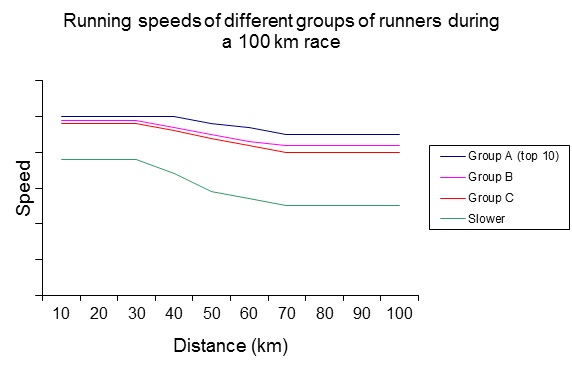How to Pace yourself in Comrades
Most runners participating in the Comrades Marathon this year will have watched a previous Comrades marathon at some point, either live or on TV, and many will have participated previously in the race. Despite this, however, many on the start-line will ruin their race by starting at the incorrect pace relative to their training and ability.
Running speed changes during the course of ultra races in a fairly predictable way, which differs between the faster and slower runners. Professor Mike Lambert, together with other researchers from the Division of Exercise Science and Sports Medicine of the Department of Human Biology of the University of Cape Town, found interesting pacing characteristics when they analysed the pacing strategy of runners who had competed in a world championship 100k race. This race was on a 10 km loop course and thus it was possible to get the split times for each 10 km of each of the 67 runners who completed the race. These runners were divided into groups of 10, starting from the first 10 to finish the race (Group A), the next 10 (Group B), and so on. The results are shown in the Figure below:

The fastest 30 runners i.e. the first three groups of ten, started the race at a similar speed, but the remaining runners started at a slower speed. However, the first 10 runners to finish maintained a speed within 15% of their starting speed, while the rest slowed down by a greater amount from start to finish. The slowest runners were running at only 60% of their initial speed by the end of the race.
Typically, the top ten runners maintained their speed fairly well, albeit with a bit of slowing in the second half. In contrast, slower runners were unable to maintain their starting speed for as long as the fast runners were able to. The speed of the slower runners decreased more rapidly. Looking at a broader picture, overall the top 30 runners maintained a more constant speed than the slower runners.
Examination of the analysis suggests that most runners can expect to slow down in a predictable way if they do not start faster than they ideally should. Thus for a race such as Comrades, the race can be expected to be run at a fairly constant speed initially, followed by a slowing that should then be more or less maintained through to the finish. This differs a little from the shorter Two Oceans ultra, where more of the top runners maintain a constant speed. Indeed, Oceans is run more like a marathon, whereas Comrades is more closely allied to the 100k race distance. However, similar to pacing in the Two Oceans being made complex due to the profile of the course (see companion article on Two Oceans pacing), in Comrades the picture is also made more complex than a flat race because with the “up” run, the first half is the most difficult because of the un-relentless climbing, yet the “easier” second half (although one does have the likes of “Inchanga” and “Pollys” to deal with in the second half), is also when you are most tired. So in a way these balance out: Difficult first half when “fresh”, easier second half, but more fatigued. In the “down” run, things are not really reversed and made super easy: whereas you in theory have the decent to Durban after half way to help you, not only are there again some big hills thrown in, but also in the latter stages of the down run the legs can become extremely sore, especially the quad muscles. Thus instead of being able to make good use of the downhills, every step becomes painful and you slow down anyway!
With the above in mind, then, how should one pace oneself in the Comrades “up” or “down” runs?
First, choose a realistic possible finishing time from the table that follows. This was compiled by Jan Louw and published in Comrades Marathon Update in 1989 and subsequently published in adapted format in “Lore of Running” by Professor Tim Noakes.
When using the table, go to the “current performance” section and choose a race distance to work from, the longer the better. Then move to the column on the right that represents your time for that distance. The time that you have run for the race distance you are using must reflect your current “form”. Its no good, for example, if you ran a 3hr marathon in January, but have lost speed since then and are now in 3:15 shape. You will then have to use 3:15 as your race time in the table. Next, go to the “Training Grid” and choose the row that represents the training distance you have done. Now move across to the right, until you meet the column that corresponds with the time for the race that you chose initially. That will be your predicted Comrades time. For example, if you ran a marathon in 3 hrs, and you have done around 1700 km (1682 km on the table), then you will have a predicted Comrades time of 7hrs 28 mins. The next step is to work that out to mins and secs per km (in this case, close to 5 min/km). That is your average speed for the race. Next, from the previous discussion on the expected slow down over the distance, bearing in mind the point with respect to more and less difficult halves and fatigue, pain, etc, decide on how “even” you think you can run the two halves. A good guide is that if you are well trained and done quite a few long runs over 50kms, then expect 10 to 15 mins longer for the second half. Thus your first half will have to be some 5 sec/km quicker than a perfect evenly paced race. If you are expecting a fairly slow overall time, keep in mind that planned walking for a few minutes every so often may be useful.
Speaking of walking, there may come a time in the race that despite applying your pacing strategy, that things go badly wrong and walking is all that you can do. If that happens, keep in mind the words that a fellow runner was once told by a club-mate: “No matter what happens, just make sure you move one step at a time towards Durban (or Pietermaritzburg) and you will eventually get to the finish”.

